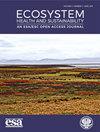Formation and functions of arbuscular mycorrhizae in coastal wetland ecosystems: A review
IF 3.4
2区 环境科学与生态学
Q1 ECOLOGY
引用次数: 3
Abstract
ABSTRACT Context Coastal wetlands are ecotones interspaced by land and ocean and are among the most sensitive and vulnerable ecosystems worldwide. They are unique in hydrological, edaphic, atmospheric, and biological characteristics, and play important roles in maintaining the ecological security and ecosystem services of coastal zones. Arbuscular mycorrhizae (AM) are symbiont composed of plant roots and arbuscular mycorrhizal fungi (AMF), which are soil-borne microorganisms widely distributed in various habitats. Many previous studies on mycorrhiza have focused on terrestrial ecosystems while few on wetlands, especially coastal wetlands. Method We systematically reviewed previous relevant studies to explore the formation and functions of AM in coastal wetland ecosystems as well as the environmental factors that affect them. Habitat characteristics, morphological types, and species diversity of AMF in the coastal wetlands were summarized. Both responses of AMF to environmental factors during AM formation and the functions of AM in coastal wetlands were discussed. Result AMF are worldwide distributed in coastal wetland and are mainly limited by flooding, hypoxia, soil pH, salinity and the host plants identification. AMF play important roles in coastal wetlands, involving promoting nutrient uptake of host plants, improving the characteristics of rhizospheric soil, and enhancing plant resistance to salt and flooding stress. Conclusion More comprehensive studies of AMF in vitro in coastal wetlands would be helpful for the conservation and restoration of coastal wetland ecosystems in the changing world.丛枝菌根在滨海湿地生态系统中的形成与作用
摘要背景海岸湿地是陆地和海洋交错带,是世界上最敏感、最脆弱的生态系统之一。它们具有独特的水文、土壤、大气和生物特征,在维护沿海地区的生态安全和生态系统服务方面发挥着重要作用。丛枝菌根(AM)是由植物根系和丛枝菌根真菌(AMF)组成的共生体,是广泛分布在各种生境中的土传微生物。以往许多关于菌根的研究都集中在陆地生态系统上,而很少关注湿地,尤其是沿海湿地。方法系统回顾前人的相关研究,探讨AM在滨海湿地生态系统中的形成、作用及其影响因素。综述了滨海湿地AMF的生境特征、形态类型和物种多样性。讨论了AM形成过程中AM对环境因子的响应以及AM在滨海湿地中的作用。结果AMF广泛分布于滨海湿地,主要受淹水、缺氧、土壤pH、盐度和寄主植物鉴定等因素的限制。AMF在滨海湿地中发挥着重要作用,包括促进寄主植物的营养吸收,改善根际土壤的特性,增强植物对盐和洪水胁迫的抵抗力。结论更全面地研究AMF在沿海湿地的体外作用,将有助于在不断变化的世界中保护和恢复沿海湿地生态系统。
本文章由计算机程序翻译,如有差异,请以英文原文为准。
求助全文
约1分钟内获得全文
求助全文
来源期刊

Ecosystem Health and Sustainability
Environmental Science-Management, Monitoring, Policy and Law
CiteScore
7.10
自引率
2.00%
发文量
40
审稿时长
22 weeks
期刊介绍:
Ecosystem Health and Sustainability publishes articles on advances in ecology and sustainability science, how global environmental change affects ecosystem health, how changes in human activities affect ecosystem conditions, and system-based approaches for applying ecological science in decision-making to promote sustainable development. Papers focus on applying ecological theory, principles, and concepts to support sustainable development, especially in regions undergoing rapid environmental change. Papers on multi-scale, integrative, and interdisciplinary studies, and on international collaborations between scientists from industrialized and industrializing countries are especially welcome.
Suitable topics for EHS include:
• Global, regional and local studies of international significance
• Impact of global or regional environmental change on natural ecosystems
• Interdisciplinary research involving integration of natural, social, and behavioral sciences
• Science and policy that promote the use of ecological sciences in decision making
• Novel or multidisciplinary approaches for solving complex ecological problems
• Multi-scale and long-term observations of ecosystem evolution
• Development of novel systems approaches or modeling and simulation techniques
• Rapid responses to emerging ecological issues.
 求助内容:
求助内容: 应助结果提醒方式:
应助结果提醒方式:


